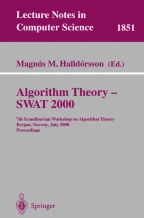Abstract
We propose a blocked version of Floyd’s all-pairs shortest-paths algorithm. The blocked algorithm makes better utilization of cache than does Floyd’s original algorithm. Experiments indicate that the blocked algorithm delivers a speedup (relative to the unblocked Floyd’s algorithm) between 1.6 and 1.9 on a Sun Ultra Enterprise 4000/5000 for graphs that have between 480 and 3200 vertices. The measured speedup on an SGI O2 for graphs with between 240 and 1200 vertices is between 1.6 and 2.
Access this chapter
Tax calculation will be finalised at checkout
Purchases are for personal use only
Preview
Unable to display preview. Download preview PDF.
References
W. AbuSufah, D. J. Kuck, and D. H. Lawrie. Automatic program transformation for virtual memory computers. In Proc. of the 1979 National Computer Conference, pages 969–974, New York, 1979.
A. Aggarwal, K. Chandra, and M. Snir. A model for hierarchical memory. In The 19th Annual ACM Symposium on Theory of Computing, pages 305–314, New York, 1987.
A. Aggarwal, K. Chandra, and M. Snir. Hierarchical memory with block transfer. In The 28th Annual IEEE Symposium on Foundations of Computer Science, pages 204–216, LosAngeles, CA, 1987.
A. Aggarwal, M. Horowitz, and Hennessey. An analytical cache model. The ACM Transactions on Computer Systems, 7(2):184–215, 1989.
I. Al-Furaih and S. Ranka, Memory hierarchy management for iterative graph structures. Proc. 12th International Parallel Processing Symposium’ 98. (IPPS98), Orlando, Florida.
I. Al-Furaih and S. Ranka, Ibraheem Al-Furaih and Sanjay Ranka, Practical Algorithms for Internal and External Sorting, Proc. the Second International Conference on Parallel and Distributed Computing and Networks (PDCN’98), Brisbane, Australia, 14–16 December 1998.
B. Alpern, L. Carter, E. Feig, and T. Selker. The uniform memory hierarchy model of computation. Algorithmica, 12(2–3):72–109, 1994.
D. Callahan, S. Carr, and K. Kennedy. Improving register allocation for subscripted variables. In In Proceedings of the ACM SIGPLAN’ 90 Conference on Programming Language Design and Implementation, White Plains, New York, 1990.
D. Gannon and W. Jalby. The influence of memory hierarchy on algorithm organization: Programming FFTs on a vector multiprocessor. In The Characteristics of Parallel Algorithms, MIT Press, Cambridge, 1987.
G. H. Golub and C. F. Van Loan. Matrix Computations. Johns Hopkins University Press, Baltimore, 1989.
E. Horowitz, S. Sahni, and S. Rajasekaran. Computer Algorithms. Computer Science Press, New York, 1998.
M. S. Lam, E. E. Rothberg, and M. E. Wolf. The cache performance and optimizations of blocked algorithms. ACM, 26:63–74, 1991.
A. LaMarca and R. E. Ladner. The influences of caches on the performance of heaps. The ACM Journal of Experimental Algorithms, 1(4), 1996.
A. LaMarca and R. E. Ladner. The influences of caches on the performance of sorting. In The ACM-SIAM Symposium on Discrete Algortihms, pages 370–379, New Orleans, Louisiana, 5–7 January, 1997.
M. Martonosi, A. Gupta, and T. Anderson. Memspy: analyzing memory system bottlenecks in programs. In Proceedings of the 1992 ACM SIGMETRICS Conference on Measurement and Modeling of Computer Systems, pages 1–12, Newport, Rhode Island, 1992.
A. C. McKeller and E. G. Coffman. The organization of matrices and matrix operations in a paged multiprogramming environment. CACM, 12(3):153–165, 1969.
Sun Microsytems. Introduction to Shade. Manual, Sun Microsytems, Mountain View, CA, 1998.
D. Patterson and J. L. Hennessy. Computer Architecture: A Quantitative Analysis. Morgan Kaufmann, San Mateo, CA, 1996.
J. P. Singh, H. S. Stone, and D. F. Thiebaut. A model of workloads and its use in miss-rate prediction for fully assocaitive caches. IEEE Transactions on Computers, 41(7):811–825, 1992.
Larry Stewart. Programming to Optimize Cache Memory on the SUN Ultrasparc-IIi Processor. Master’s thesis, University of Florida, Gainesville, FL, April 1999.
P. Sulatycke and K. Ghose, Caching-efficient multithreaded fast multiplication of sparse matrices. Proceedings 12the International Parallel Processing Symposium, 117–123, 1998.
O. Temam, C. Fricker, and W. Jalby. Cache interference phenomena. In Proceedings of the 1994 ACM SIGMETRICS: Conference on Measurement and Modelling of Computer Systems, pages 261–271, Nashville, Tennessee, 1994.
O. Temam, C. Fricker, and W. Jalby. Influence of cross-interference on blocked loops: A case study with matrix-vector multiply. The ACM Transactions on Programming Languages and Systems, 17(4):561–575, 1994.
H. Wen and J. L. Baer. Efficient trace driven simulation methods for cache performance analysis. The ACM Transactions on Computer Systems, 9(3):222–241, 1991.
M. E. Wolf and M. S. Lam. A data locality optimizing. In In Proceedings of the SIGPLAN’ 91 Conference on Programming Language Design and Implementation, pages 30–44, Toronto, Ontario, Canada, 1991.
Author information
Authors and Affiliations
Rights and permissions
Copyright information
© 2000 Springer-Verlag Berlin Heidelberg
About this paper
Cite this paper
Venkataraman, G., Sahni, S., Mukhopadhyaya, S. (2000). A Blocked All-Pairs Shortest-Paths Algorithm. In: Algorithm Theory - SWAT 2000. SWAT 2000. Lecture Notes in Computer Science, vol 1851. Springer, Berlin, Heidelberg. https://doi.org/10.1007/3-540-44985-X_36
Download citation
DOI: https://doi.org/10.1007/3-540-44985-X_36
Published:
Publisher Name: Springer, Berlin, Heidelberg
Print ISBN: 978-3-540-67690-4
Online ISBN: 978-3-540-44985-0
eBook Packages: Springer Book Archive
